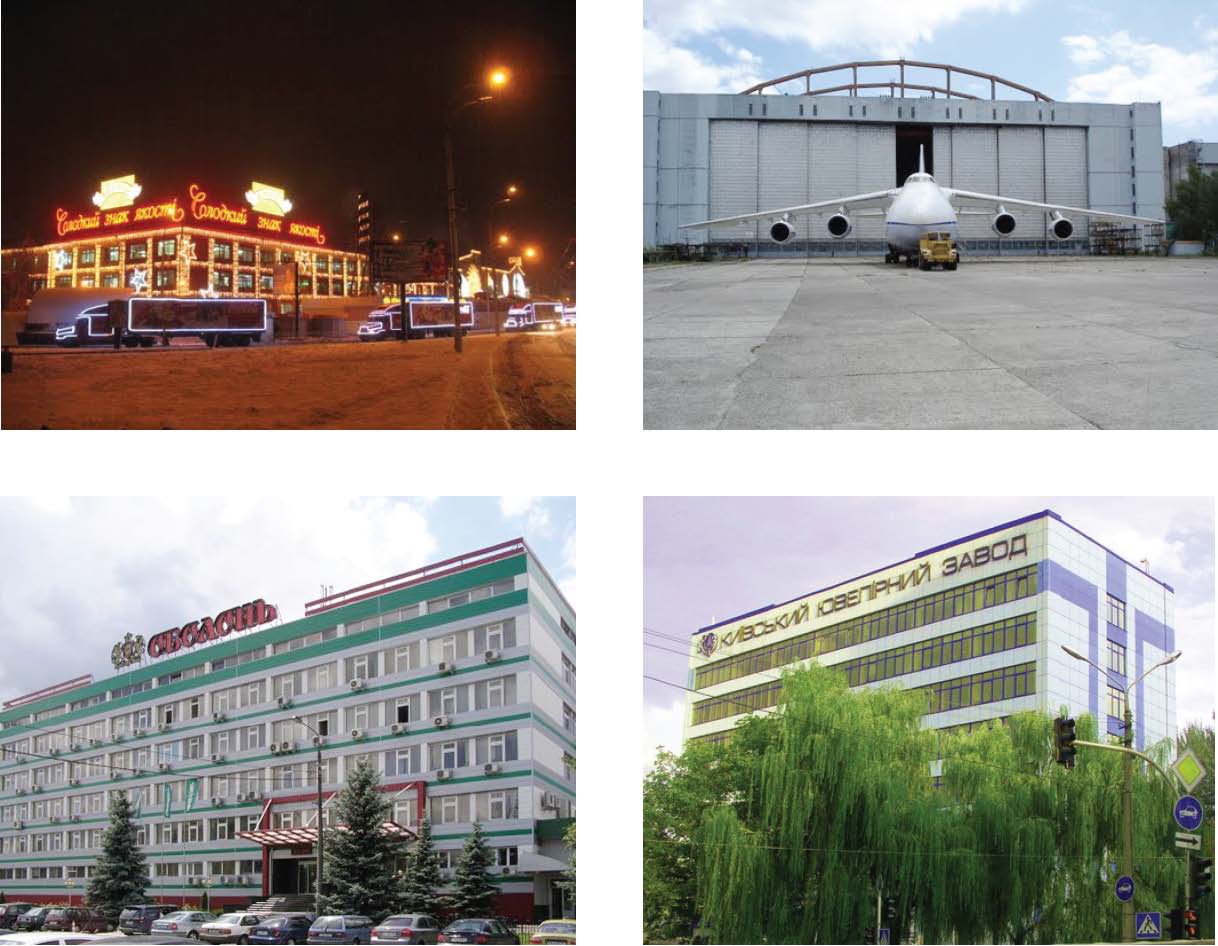1. Basic Lines of Social and Economic Development
Conceptual principles and priorities of economic development, industrial policy, housing policy, development of social sphere are defined according tothe Strategy for the development of Kyiv city by 2025, developed on the request of Main Department for Economic and Investments of Kyiv City State Administration.
Kyiv will be developed as the state center of administration, science, culture, education, sports and tourism of Ukraine, as well as the leading multi-business and scientific-educational center of Eastern Europe and Black Sea Region in the field of business services.
Complex analysis and forecast of demographic development
of Kyiv city and suburban areas
Current situation of demographic development.
Particularities of the development of Kyiv are caused by the fact, that the city is the capital of Ukraine, the main educational, cultural, scientific and industrial center.
Kyiv is the only region out of 27 ones in the country with constantly increasing population at the beginning of ХХІ century, particularly, a number of resident population have increased for 190,3 thousand over the last 10 years and the present population – for 186,1 thousand. As of January 01, 2011, a resident population size (according to the state statistics) was 2.76 millionand the present population – 2,8 million.
Kyiv is the main center of influx of immigrants. In 2010, the number of persons arrived to Kyiv exceeded the number of those who left it for 10,6 thousand.
The actual population of Kyiv city (including those who actually live in Kyiv and are not covered by the state statistics) is 3,14 million people. The daytime populationof Kyiv city (including organized and unorganized tourists, persons, who are guests, in transit, on business trip), as well as daytime visitors – excursionists, commuters, traders, patients of medical institutions from other regions) in early 2010 is approximately 3390,1 - 3511,9 thousand.
Complex forecast of demographic development. The forecast of the number and structure of the population of Kyiv city has been provided by the Institute for Demography and Social Studies of the National Academy of Science of Ukraine.
According to the Strategy for the development of Kyiv city by 2025, the main forecasting figures of demographic development of the city have been accepted: the number of resident population is 3,15 million, actual population is 3,7 million, daytime population is up to 4,0 million.
In the long-term, in 2050, the stabilization of resident population size of Kyiv city could be expected at 3,5–3,6 million, and 1,1–1,2 million–for suburban area.
It is recommended to take a set of measures to improve demographic situation, rise birth rate and extend a lifetime of Kyivan, referring to:
- Preservation and improvement of population health;
- Development and implementation of programs for the health care reform;
- Improvement of mother and child care system;
- Improvement of working conditions and compliance with its requirements;
- Improvement of living conditions, increase volumes of construction of social and affordable housing;
- Reducuction of unemployment, creating new vacancies;
- Strengthening of control of dangerous asocial phenomena;
- Promotion and stimulation of healthy lifestyle;
- Improvement of the state of city environment;
- Implementation of other measures on natalism and family support.
Gender and age structure of the population of Kyiv city as of early 2026

Analysis and forecast of demographic development of Kyiv city in 2026

Conceptual principles and priorities
of economic development of Kyiv city
The city of Kyiv is the capital of Ukraine, one of the largest states by the population and area among the European countries, the center of national and regional system of settlement and inter settled social-economic and industrial relations.
The role of Kyiv city in the international relationshas all basis for further growth due to its geopolitical location, allocation in the system of global informational, cultural, energetic, transportation relations.
Unique climate and natural landscape conditions also contribute to its social-economic and city-planning development.
In the area of influence of Kyiv city, as the center of formatted local system, the following towns are located: the town of Brovary with the population of 60 thousand, the town of Boryspil – 50 thousand of persons, the town of Vasylkiv – 40 thousand of persons, and others, composing the near area of Kyiv city monocentric agglomeration, as well as rural settlements and villages with the population from 3 till 20 thousand of persons.
Demographic capacity of area of Kyiv city with population of suburban area is about 5 million people. Such concentration of population provides a full execution of functions of Kyiv as the capital city and corresponds to trends of the majority of European countries.
Kyiv city has a special status in the system of administrative and territorial structure of the state; central governmental authorities, local and regional authorities, foreign diplomatic missions are located there. 10 districts are established in Kyiv city according to the administrative and territorial structure.
Kyiv is a powerful scientific and industrial, educational, cultural, touristic, religious center of Ukraine and Europe, with a mixed and multifunctional economy, fast-growing market for goods and services.
The city takes leading positions on the most indicators of social-economic development, creating and providing almost 19% of gross domestic product and 35% of revenues to the state budget of Ukraine over the last years. Kyiv city is ahead of the average Ukrainian value of gross regional product per one person for more than 3,2 times.
Natural and geographic location of Kyiv, surrounded by agriculture lands, forests, water basins, is favorable for long-term spatial development.
Kyiv has a well-developed external infrastructure, which provides convenient connections from the city to other countries and regions of Ukraine by means of air, railway and highway communication.
In compliance with specified natural, scientific and technical, economic potential of the city, the Strategy defined the mission, principles and priorities of social-economic development of Kyiv city for its long-term development.
The mission of Kyiv as the capital of Ukraine is in the further development of the state center of administration, science, culture, education, sports and tourism; creation of comfortable and safety surroundings in the city of Kyiv focusing on the gradual achievement of European quality of life, providing of worthy conditions and equal possibilities for full development and personal fulfillment of present and future generations of Kyiv.
Areals of spatial influence of the city of Kyiv
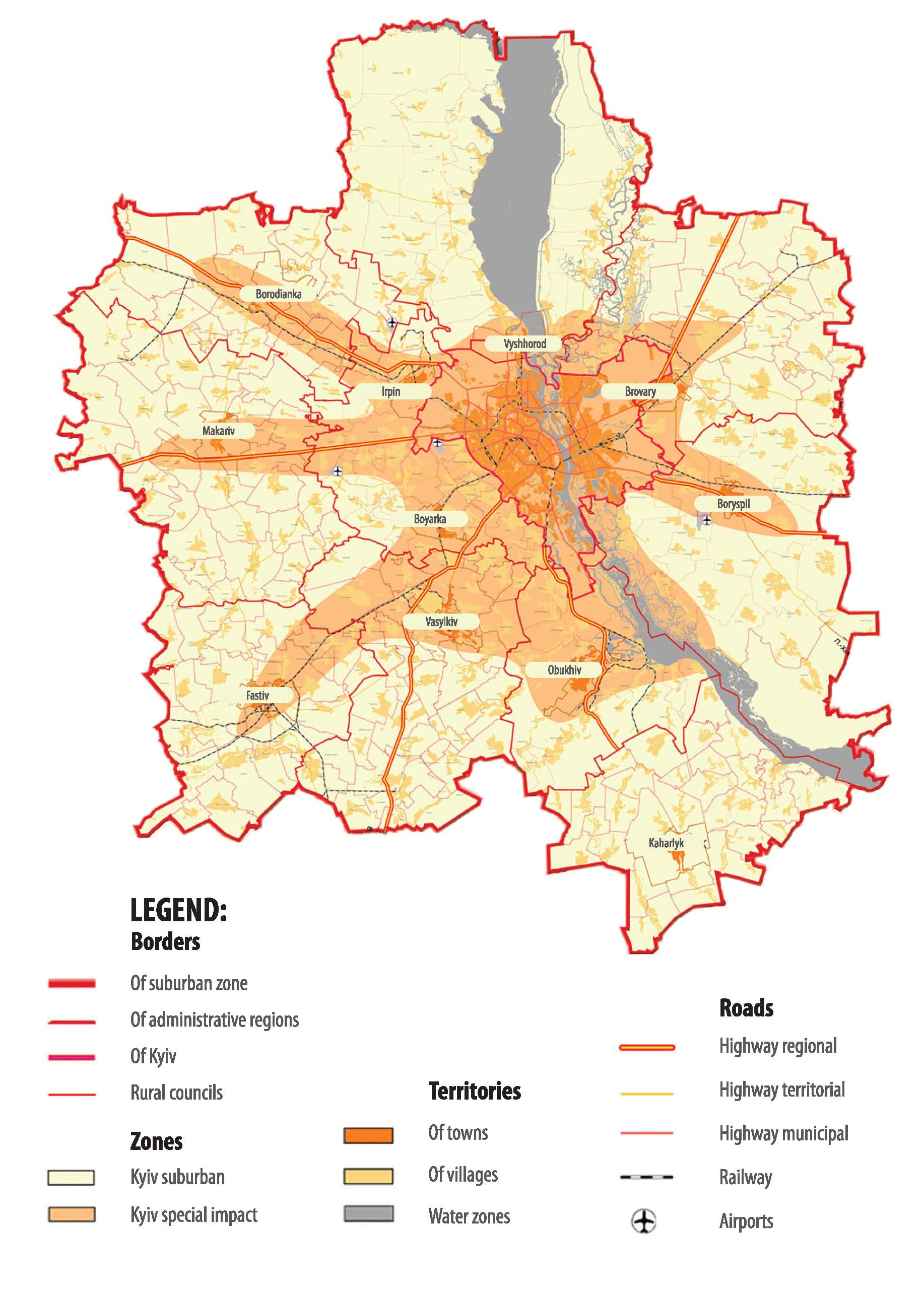
The mission of Kyiv provides the solution of social problems of Kyiv city and its residents through effective development of priorities and fields of local economy in compliance with scientifically grounded environmental requirements, including:
- formation of creative innovative city with the development of scientific and technical clusters and involving of the best companies and developed human potential for these purposes;
- preservation of unique properties of the city, its historic and cultural heritage;
- improvement of living standards and quality of living environment, working and business conditions;
- creation of open and competitive economy with targeted investments and suited budget of the development;
- implementation of effective city administration system and open regulations of the activity of local authorities;
- development of social partnership, concentration of resources on the solution of systemic problems.
Main principles of sustainable development of the city are based on the key provisions of the Program of Action “The agenda for ХХІ century”, conclusions of the United Nations Conference on the development of Human Settlements (Habitat-II) and relevant recommendations of the European economic commission of the United Nations and Council of Europe, and directed to the following:
- a balanced development of economic, environment and social spheres;
- priority of intensive over extensive development;
- sustainable use of areas of the city, harmonious combination of historical and modern buildings, preservation of green plantings, statement of the international reputation of the city of Kyiv as the green city with unique landscapes, water basins, parks and squares;
- termination of selective building and transition to the complex reconstruction and building of neighborhoods of out of date housing fund, lacking conveniences and degraded territories;
- priority of the development of spheres of official issues and other commercial purposes on the left bank of the city for the creation of balanced conditions of employment;
- complex development of administrative districts in the city of Kyiv in compliance with the specific of its production and recourse potential;
- concentration of resources on the solution of systemic problems and stimulation of priorities of production (growing points).
- Compact city. Control of territorial growth of the city for reduction of stress loads and costs on the engineering and transport infrastructure. The priority of internal development and landscaping of the city. Sustainable usage of free city land resources, modernization of out of date housing fund, renewal of degraded industrial, storage and other areas;
- Cultural and business center of the country. Big business initiatives. Activation of the potential for the development of the capital. Extension of international relations and projects. Increasing of competitiveness of the economy. Development of economic sciences. Improvement of investment climate. Development of cultural institutions in compliance with demands of different social and age groups and persons with special needs. Expansion of the number of children’s preschool and after-school institutions, places of cultural communication for youth;
- Balanced development of the city and agglomeration. Coordinated regulation of usage and building of suburban areas (Kyiv agglomeration). Creation of sole transport and planning framework of the city and suburban area. Development of high-speed electric transportation for providing of connection of settlements and place of labor of the city and suburban area. Providing of building of objects of common interests.
- Responsibility for the future generation. Preservation of historic environment, monuments of world, national and local significance, its sustainable usage for historic tourism. Preservation and improvement of unique natural landscape, the level of landscape gardening, enrichment of ecosystems, creation of new green plantings, parks, squares, extension of public green areas. Improvement of air and water quality and cleaning service of the city. Cleanness of areas;
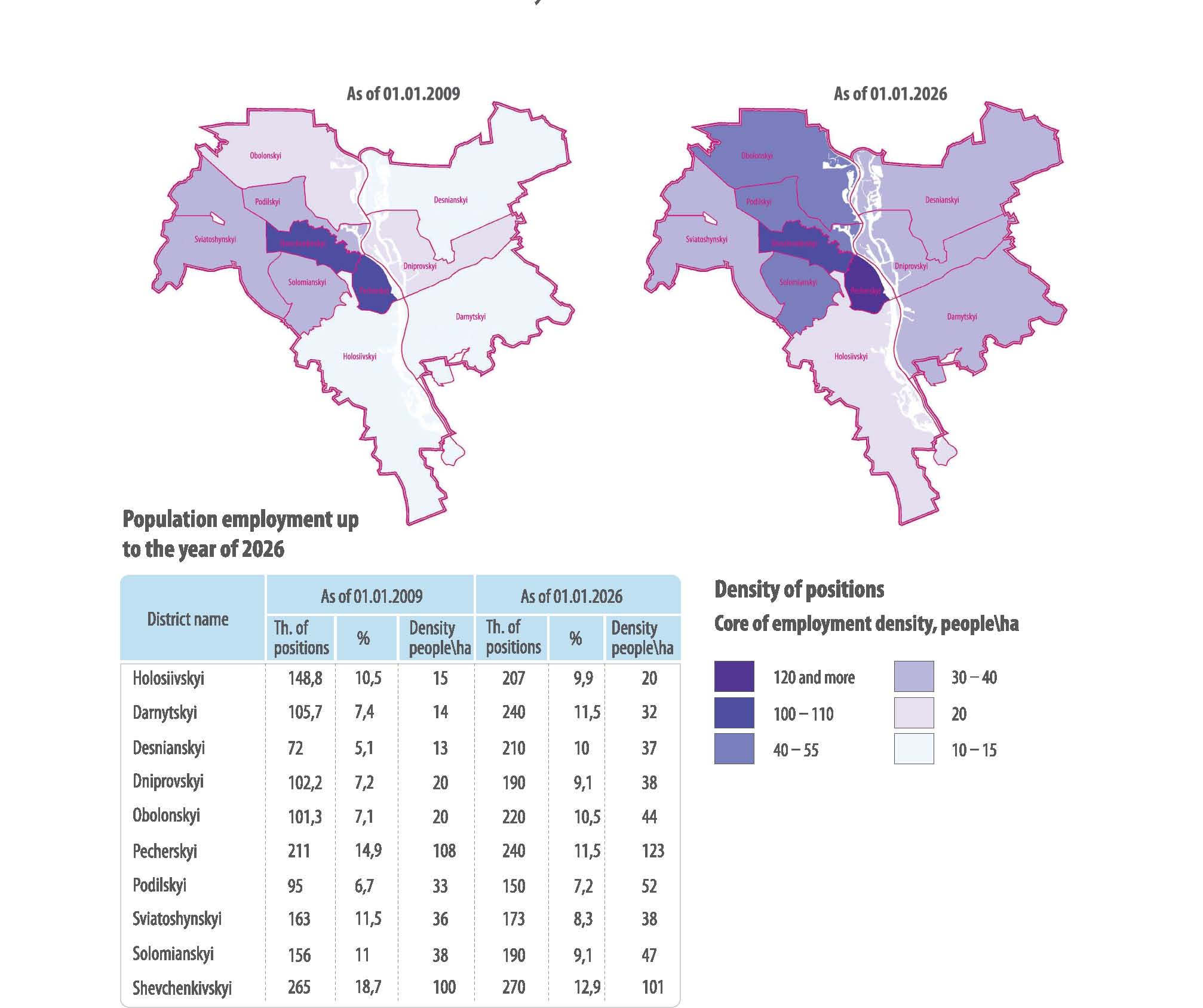
Density of allocation of labor
- Attractive and humane city. Improvement of living conditions in urban areas to the standard of the European capitals. Liberalized access to housing. Compliance with demands in housing for future generation. Possibility of buying a property for middle-income families. Providing of social housing for individuals, who require social support. Ensuring of public safety and providing of quality household, medical and public services. Development of sports and physical training infrastructure. Compliance with demands of disabled persons.
- Mobile and affordable city. Balanced settlement and employment both on the left and the right banks of the city. Priority in the development of public high-speed electric transport. Improvement of transport connections between separate districts. Prolongation and density of motorways. Building of tunnels, bridges, interchanges and parking lots. Providing comfortable transport connections with suburban areas. Up to 30-40 minutes of time saving for getting from home to a working place;
- Principles of planning and control for realization of General Plan, monitoring of city-planning activity, creation of city-planning cadastre. Implementation of fi eld development programs.
- The first stage (by 2013)– negotiation of consequences of fi nancial crisis, reorganization of banking system, achievement of macroeconomic stabilization and formation of organizational conditions for innovative transformation of the economy.
- The second stage (2013–2020)– a period of progressive institutional and structural transformations, transition of the city to investment and innovative development model.
- The third stage (2021–2025)– achievement of specifi ed strategic objectives and targeted quality of life indicators (schedule 2.2), adjustment of city development directions under new social-economic conditions.
Targeted values of social-economic development of Kyiv city by 2025
The main directions of social-economic policy
According to the targeted values of the Strategy for the development of Kyiv city, the increase of labor forces of the capital up to 2 399,4 thousand people is expected in 2025 (for 15,9 %, compared to 2010), among which – 82,5 % (1 980,0 thousand of persons) will be employed.
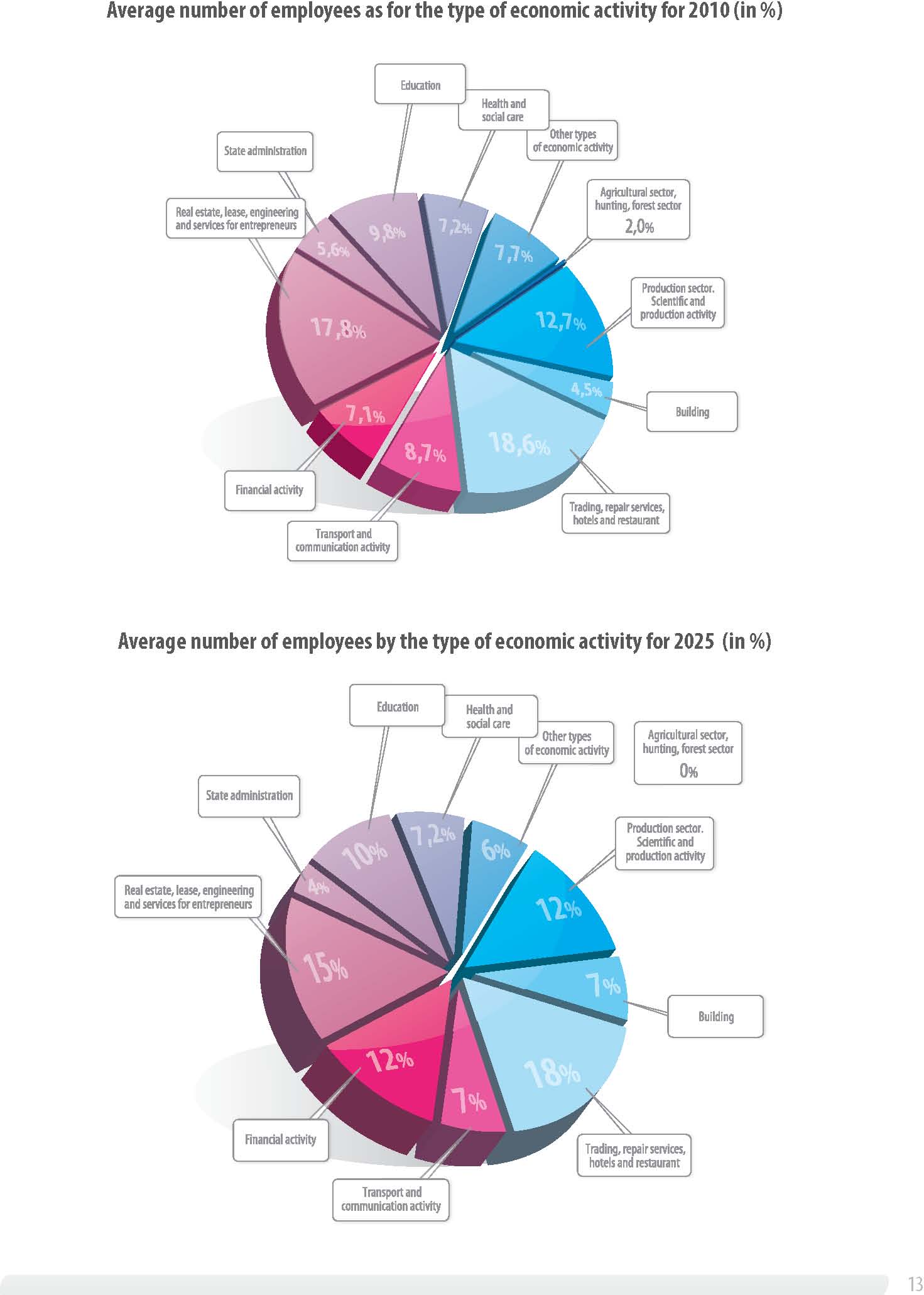
Housing policy
The main directions of housing policy for providing accommodation, improvement of its quality and affordability for a long period of time, are the following:
- Increasing of total value of housing fund till the end of 2025 – by 28,5 million square meters and finishing at 86,4 million square meters;
- Slum clearance of about 4,0 million square meters, including 2,05 million square meters by 2025;
- Increase of average housing provision of population, not less than by 30,0 square meters per 1 person, and by the end of 2025 – not less than 27,5 square meters per 1 person;
- Gradual accumulation of annual volume of housing construction to 2,0 million square meters in 2025;
- Long-term modernization and complex reconstruction of slum housing areas, in the volume of 8 million square meters and creation of housing fund, prescribed for resettlement of citizens from houses of light-construction, hostels and other uninhabitable buildings;
- Formation of municipal fund of social and affordable housing, which should be given for free or rented out on special terms to low-income citizens and those in need;
- Annual increasing of the volume of social building construction to 0,2 million square meters of the total area with the average area of one-room apartment of up to 40 square meters, two-room apartment of up to 52-55 square meters, three-room apartment of up to 60 square meters;
- Implementation of progressive energy-efficient architecture and planning, constructive and engineering solutions in design of residence buildings in order to improve its performance, using energy- and resource-efficient technologies, reduction of construction costs.
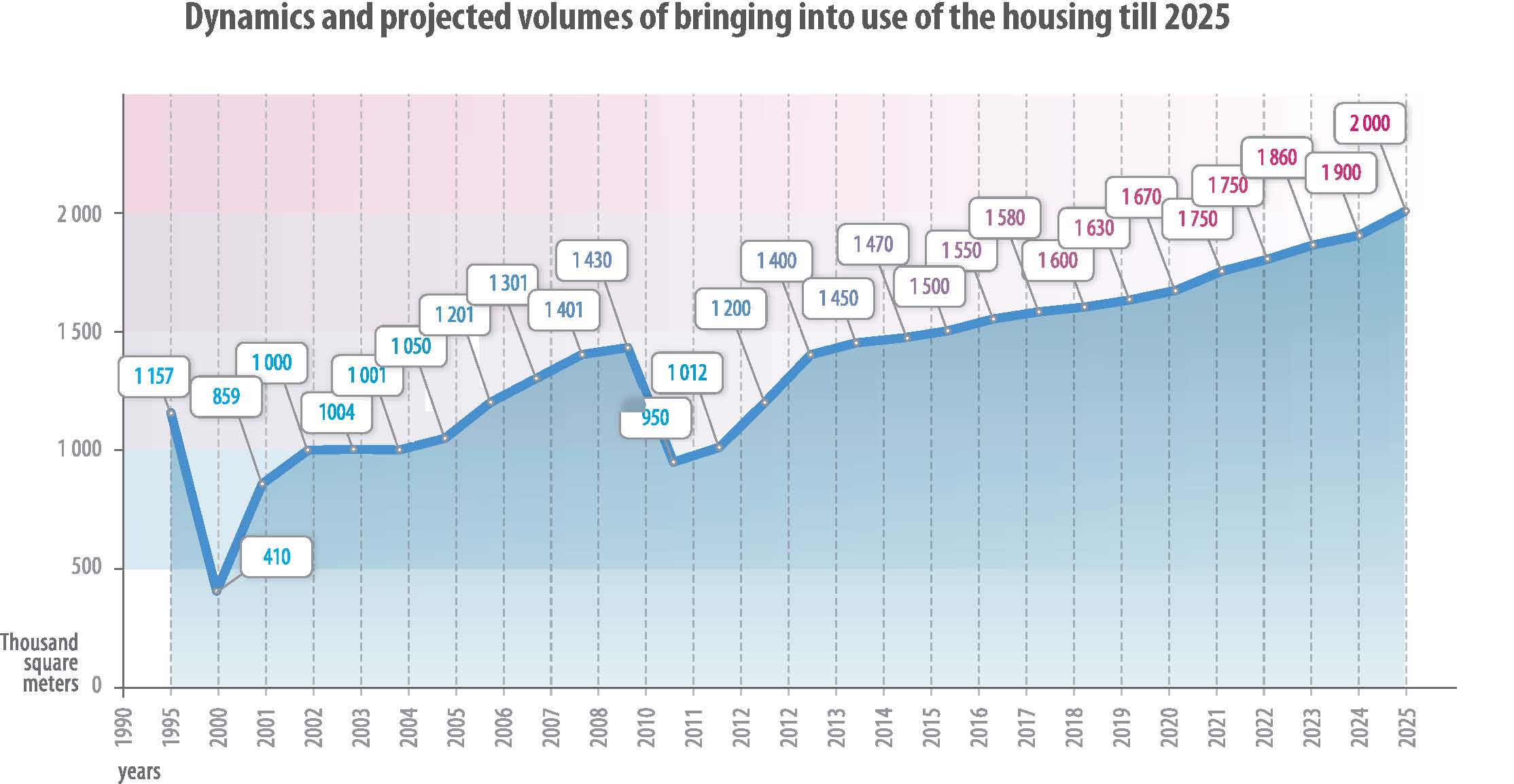
Fiscal policy:Mobilization of financial resources of the city (budget, credit, personal costs of enterprises, institutions and organizations, extra-budgeting funds, foreign investments, etc.), their consolidation for the purposes of strategic development of Kyiv city and execution of functions of the capital;
- Creation of favorable investment environment to attract corporate and private investments; realization of rights, specified by the law, relative with state guarantees of preservation of investments, which are engaged for the development of infrastructure of the city (article 21, clause 6 of the Law of Ukraine “On the capital of Ukraine – City-Hero Kyiv”);
- Profound cooperation with international financial organizations due to engagement of credit resources for social development, engineering and transport infrastructure and modernization of the economy;
- Formation of budget funds of investment activity plans by chief controllers specifying innovative and investment projects and establishing specific measures of effi ciency of the execution of specified purposes, increasing in control of relevancy of projects budget, financed by public funds.
Investment policy:Implementation of efficient mechanisms of stimulation of investment processes in priority sector of economic complex of the city, creation of the mode of maximum assistance to investors in new building construction and reconstruction of existing facilities of city engineering and transport infrastructure, housing construction, hotel construction, etc.;
- Creation of conditions for reorientation of private investments into types of economic activity, which should defi ne specialization of the capital in the international division of labor (business services, high-technological and aerospace engineering, biotechnologies, production of new materials with specified properties, telecommunication, tourism).
Industrial policy:Development of “leading” and “breakthrough” technologies of international standard: rocket and space, and aviation equipment; household equipment and municipal electric engineering; diagnostic and care program-technical complexes; nanostructured materials with specifi ed properties, nanoelectronics, nano-chemical and nano-biological technologies; functional materials for electronics, instrument-making and medicine; substances and materials for household chemistry and food industry; biotechnology for health care, pharmacology and agricultural sector, new generation of drugs, etc.;
- Organization of equal product release to imported products (by means of technological imitation), primarily oriented on demands of the city: building materials, measurement equipment, metering equipment, communication systems, environment protection and waste utilization, pharmaceuticals, etc.;
- Restructuring of enterprises with low level of fiscal efficiency or those which do not comply with environment safety standards;
- Development of manufacture of products with new or upgraded properties by consumers, as well as infrastructures, which provide services for business;
- Creation of technopolises on the basis of universities and scientific and research institutions of the National Academy of Science of Ukraine, industrial and innovative and technological clusters, industrial parks, technological development areas, oriented on the realization of innovative cycle.
About 222 thousand of persons (staff ) will work in the industrial complex in 2025.
Engineering, manufacture of food products, beverages and tobacco products, chemical and oil-chemical industries, cellulose and paper manufacturing and publishing. More than 72% of production, 66% of staff and 80% industry assets will suit these sectors.
Share of sold industry products by types of activity
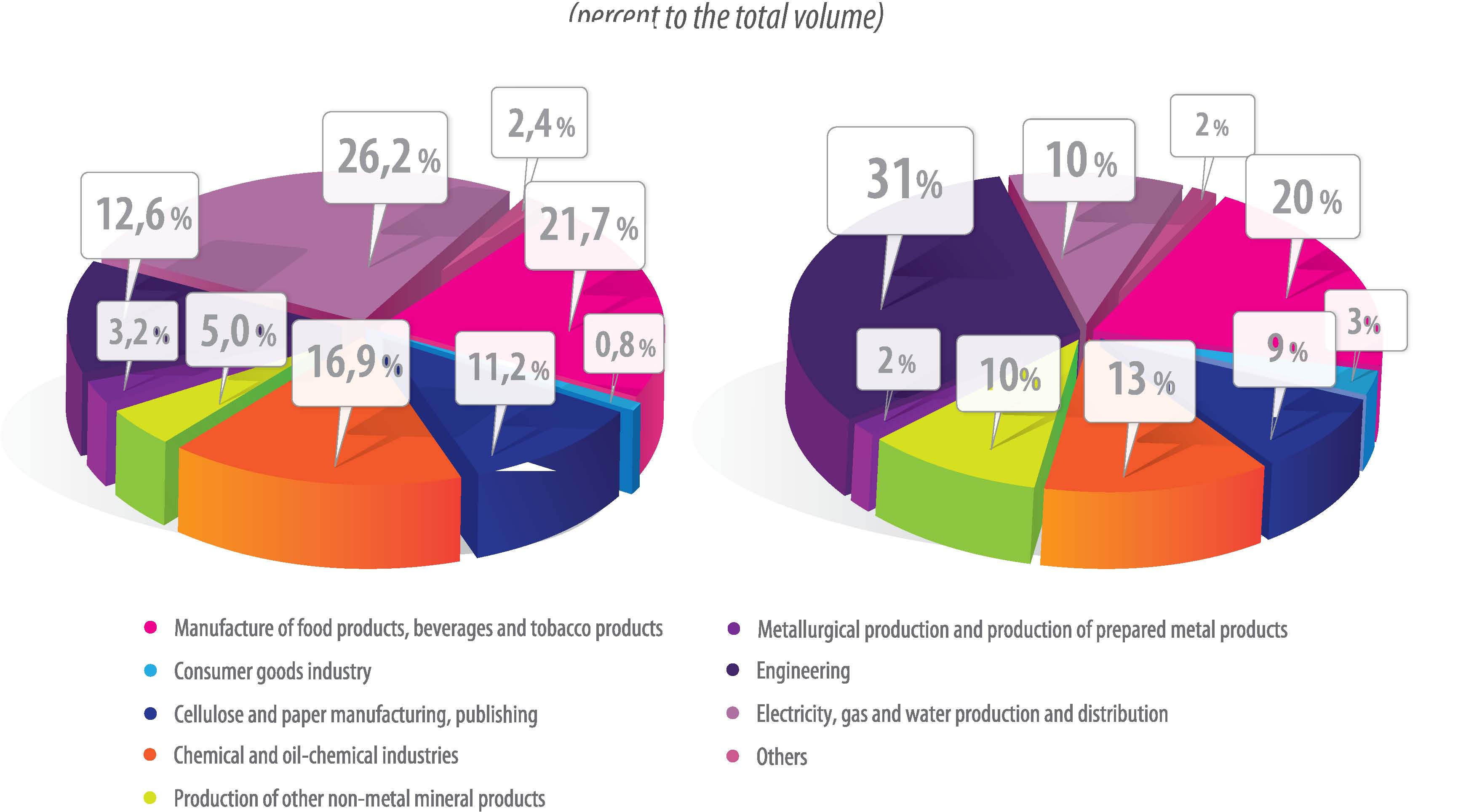
Building complex of the city
Construction and installation organizations and enterprises of building materials industry could provide specified volumes of construction under condition of expanding of its capacities and modernization of material and technical basis, by 2025 (in 2010, city companies executed 28,7% of construction and installation works out of the national volume).
It is expected, that activity of city construction and installation companies and building materials industry will be directed to:Increase of fund equipment of building works, reduction of the number of employees of manual labor, reequipment (currently the depreciation is about 49%);
- Introduction of advanced building technologies, which could provide growth of labor effi ciency;
- Extension of range and volume of building materials production;
- Production of materials and constructions, which provide reduction of mass and increase energy efficiency of structural elements of buildings;
- Priority rates of production volumes increase of metal and monolithic reinforce constructions, increase of specific density in the structure of production for increasing of the level of industrialization of building complex;
- Consolidation of potential of scientific research and design organizations of all types of ownership, severization of requirements to the quality of scientific research and development works, activation of industrial and innovative policies, directed to the improvement of coordination of fundamental and field scientific research, improvement of national system of standardization and certification;
- Expansion of volumes of civil construction, reconstruction of industrial enterprises and engineering and transport infrastructure of the city;
- Transformation of the structure of building complex, including implementation of constructions with reduced heat loss, extension of volumes of production of the whole range of heat-insulating materials, as well as production and installation of new types of engineering equipment and monitoring devices, realization of current regulations of thermal protection of buildings.
Development of entrepreneurship and its infrastructure
It is expected that, according to the targeted values of the Strategy for the development of Kyiv city, the average annual growth rate of the amount of small enterprises will be 5%. In 2025 about 134 thousands of small enterprises will operate with the total number of employees 940 thousand people.
Share of small enterprises by types of economic activity
(percent to the total volume)
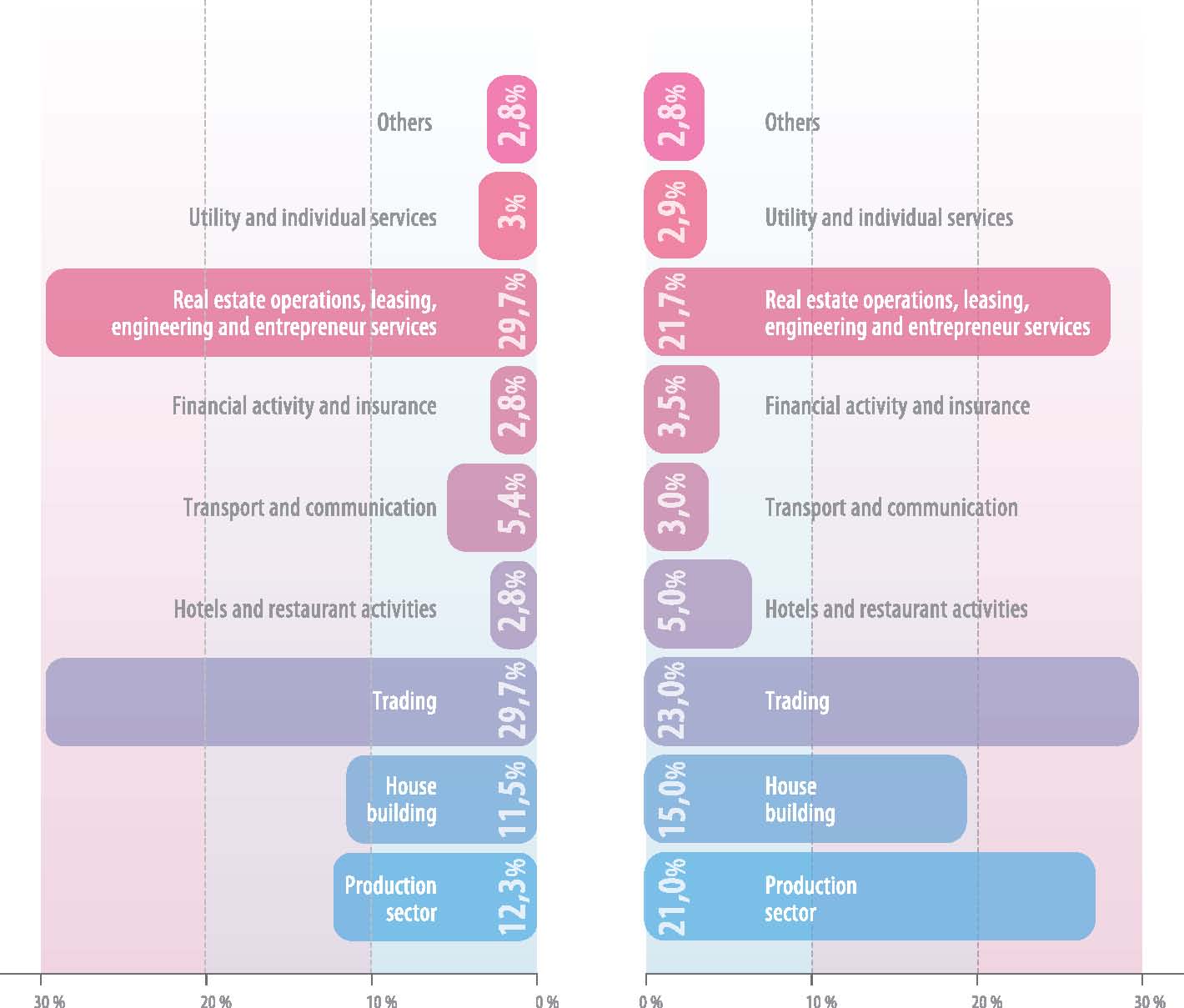
2010 2025
External economic activity:
Formation of multi-vector model of participation of Kyiv city in the international integration processes, especially with the countries of the European Union, Commonwealth of Independent States, activation of relations with countries of Asia, Africa and Southern America, includ
ing creation of bilateral working groups and commissions of trade and economic, industrial and scientific and technical cooperation;
- Development of transport and logistic infrastructure for realization of external economy activity and transit potential of Kyiv city;
- Realization of projects of import substitution, providing of protection of capital economic subjects and internal markets from unfair competition from the external producers of similar products.
Density of allocation of labor
